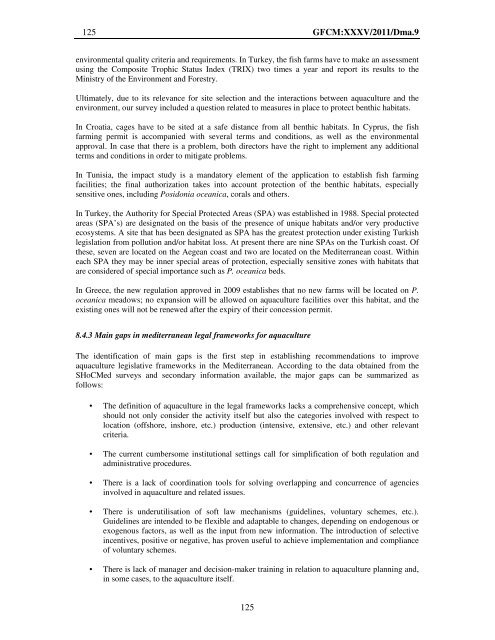Site selection and carrying capacity in Mediterranean ... - FAO Sipam
Site selection and carrying capacity in Mediterranean ... - FAO Sipam
Site selection and carrying capacity in Mediterranean ... - FAO Sipam
Create successful ePaper yourself
Turn your PDF publications into a flip-book with our unique Google optimized e-Paper software.
125 GFCM:XXXV/2011/Dma.9<br />
environmental quality criteria <strong>and</strong> requirements. In Turkey, the fish farms have to make an assessment<br />
us<strong>in</strong>g the Composite Trophic Status Index (TRIX) two times a year <strong>and</strong> report its results to the<br />
M<strong>in</strong>istry of the Environment <strong>and</strong> Forestry.<br />
Ultimately, due to its relevance for site <strong>selection</strong> <strong>and</strong> the <strong>in</strong>teractions between aquaculture <strong>and</strong> the<br />
environment, our survey <strong>in</strong>cluded a question related to measures <strong>in</strong> place to protect benthic habitats.<br />
In Croatia, cages have to be sited at a safe distance from all benthic habitats. In Cyprus, the fish<br />
farm<strong>in</strong>g permit is accompanied with several terms <strong>and</strong> conditions, as well as the environmental<br />
approval. In case that there is a problem, both directors have the right to implement any additional<br />
terms <strong>and</strong> conditions <strong>in</strong> order to mitigate problems.<br />
In Tunisia, the impact study is a m<strong>and</strong>atory element of the application to establish fish farm<strong>in</strong>g<br />
facilities; the f<strong>in</strong>al authorization takes <strong>in</strong>to account protection of the benthic habitats, especially<br />
sensitive ones, <strong>in</strong>clud<strong>in</strong>g Posidonia oceanica, corals <strong>and</strong> others.<br />
In Turkey, the Authority for Special Protected Areas (SPA) was established <strong>in</strong> 1988. Special protected<br />
areas (SPA’s) are designated on the basis of the presence of unique habitats <strong>and</strong>/or very productive<br />
ecosystems. A site that has been designated as SPA has the greatest protection under exist<strong>in</strong>g Turkish<br />
legislation from pollution <strong>and</strong>/or habitat loss. At present there are n<strong>in</strong>e SPAs on the Turkish coast. Of<br />
these, seven are located on the Aegean coast <strong>and</strong> two are located on the <strong>Mediterranean</strong> coast. With<strong>in</strong><br />
each SPA they may be <strong>in</strong>ner special areas of protection, especially sensitive zones with habitats that<br />
are considered of special importance such as P. oceanica beds.<br />
In Greece, the new regulation approved <strong>in</strong> 2009 establishes that no new farms will be located on P.<br />
oceanica meadows; no expansion will be allowed on aquaculture facilities over this habitat, <strong>and</strong> the<br />
exist<strong>in</strong>g ones will not be renewed after the expiry of their concession permit.<br />
8.4.3 Ma<strong>in</strong> gaps <strong>in</strong> mediterranean legal frameworks for aquaculture<br />
The identification of ma<strong>in</strong> gaps is the first step <strong>in</strong> establish<strong>in</strong>g recommendations to improve<br />
aquaculture legislative frameworks <strong>in</strong> the <strong>Mediterranean</strong>. Accord<strong>in</strong>g to the data obta<strong>in</strong>ed from the<br />
SHoCMed surveys <strong>and</strong> secondary <strong>in</strong>formation available, the major gaps can be summarized as<br />
follows:<br />
• The def<strong>in</strong>ition of aquaculture <strong>in</strong> the legal frameworks lacks a comprehensive concept, which<br />
should not only consider the activity itself but also the categories <strong>in</strong>volved with respect to<br />
location (offshore, <strong>in</strong>shore, etc.) production (<strong>in</strong>tensive, extensive, etc.) <strong>and</strong> other relevant<br />
criteria.<br />
• The current cumbersome <strong>in</strong>stitutional sett<strong>in</strong>gs call for simplification of both regulation <strong>and</strong><br />
adm<strong>in</strong>istrative procedures.<br />
• There is a lack of coord<strong>in</strong>ation tools for solv<strong>in</strong>g overlapp<strong>in</strong>g <strong>and</strong> concurrence of agencies<br />
<strong>in</strong>volved <strong>in</strong> aquaculture <strong>and</strong> related issues.<br />
• There is underutilisation of soft law mechanisms (guidel<strong>in</strong>es, voluntary schemes, etc.).<br />
Guidel<strong>in</strong>es are <strong>in</strong>tended to be flexible <strong>and</strong> adaptable to changes, depend<strong>in</strong>g on endogenous or<br />
exogenous factors, as well as the <strong>in</strong>put from new <strong>in</strong>formation. The <strong>in</strong>troduction of selective<br />
<strong>in</strong>centives, positive or negative, has proven useful to achieve implementation <strong>and</strong> compliance<br />
of voluntary schemes.<br />
• There is lack of manager <strong>and</strong> decision-maker tra<strong>in</strong><strong>in</strong>g <strong>in</strong> relation to aquaculture plann<strong>in</strong>g <strong>and</strong>,<br />
<strong>in</strong> some cases, to the aquaculture itself.<br />
125
















